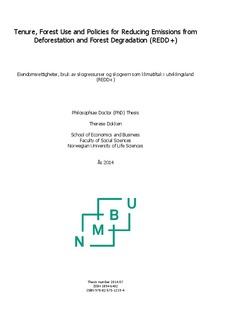| dc.description.abstract | The objectives of the thesis is to improve our understanding of what determine differences in access to and use of land and forest resources across households, introduce new methods to analyze this, and identify policy measures that can improve management of forest resources.
The decomposition method used in paper 1 is widely used in the labor market literature to explain wage differences, but it can also provide insight into why access to land differs across groups. The smaller landholdings by female-headed households’ cannot be explained by differences in household endowments and characteristics alone, but also returns to these endowments and characteristics. Such differences in indicate discrimination gender bias in access to land.
In paper 2, we identify a mismatch between statutory and customary rights. Forests within village boundaries are not necessarily recognized as village lands by the state, while the village claims communal rights and also perceive their rights as secure. We find that factors internal to the village, such as low rule compliance and enforcement among households, are challenges to achieve collective action and reduce deforestation and forest degradation.
In paper 3 and 4 we look at which households are more dependent on forest and why some households are more dependent than others. In paper 3 we propose a new method to classify households when studying the forest-poverty nexus. We argue that the stock of productive, human and liquid assets should be considered when assessing households’ poverty status, and that predicted income is a better measure of long-term income than the observed one-year income. We apply a two dimensional categorization of households, based on both observed and predicted incomes. The new classification changes a major conclusion in the forest-poverty literature for our case. One group stands out in terms of having both the highest forest reliance and absolute forest income, namely the stochastically rich. These asset-poor households have enjoyed a high income in the survey year, and have significantly higher forest income. These high forest-users are not classified as poor when using observed income, but are when using predicted income. While we fully realize that nothing can replace observing the same households over time, we believe a method combining observed and predicted income can be used to discuss some aspects of poverty, normally confined to analysis of poverty dynamics with long-running panel data.
In paper 4, I go more into depth to look at why some households are more forest reliant. I estimate the household specific shadow wages and find a negative correlation between forest reliance and the estimated shadow wage, indicating that forests at least to some groups serve as an employer of last resort. Although forest activities are characterized by low returns, poor households have few other options for income generating activities. | nb_NO |
